A Handbook for Change: Empowering Learner Agency at TYWLS of Astoria
CompetencyWorks Blog
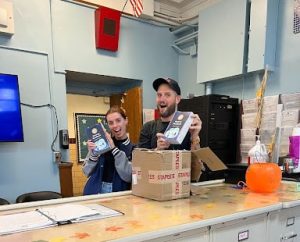 In the fall of 2022, our school ordered the first 100 copies of our Teacher Mastery Handbook – an over 100-page comprehensive guide for all things mastery-based learning at The Young Women’s Leadership School (TYWLS) of Astoria. The arrival of the handbooks was met with anticipation and excitement by the mastery team members. Everyone rushed to the main office after receiving my two-word email: “They’re here!” For those, like myself, who had been present at the apartment gathering in Midtown Manhattan one Saturday afternoon in 2010 to draft the first iteration of a mastery handbook, this moment was a long time coming, a true labor of love. It felt akin to crossing the finish line of a marathon, where the joy of accomplishment is momentarily eclipsed by a series of flashbacks to all the early morning Sunday long runs, late-night interval training sessions, blisters, shin splints, and the occasional dreaded purple toenail.
In the fall of 2022, our school ordered the first 100 copies of our Teacher Mastery Handbook – an over 100-page comprehensive guide for all things mastery-based learning at The Young Women’s Leadership School (TYWLS) of Astoria. The arrival of the handbooks was met with anticipation and excitement by the mastery team members. Everyone rushed to the main office after receiving my two-word email: “They’re here!” For those, like myself, who had been present at the apartment gathering in Midtown Manhattan one Saturday afternoon in 2010 to draft the first iteration of a mastery handbook, this moment was a long time coming, a true labor of love. It felt akin to crossing the finish line of a marathon, where the joy of accomplishment is momentarily eclipsed by a series of flashbacks to all the early morning Sunday long runs, late-night interval training sessions, blisters, shin splints, and the occasional dreaded purple toenail.
We gathered in the main office, our eager hands opening the boxes containing the handbooks, revealing the culmination of months of hard work and dedication. Each page represented a collective effort to improve our practice and enhance our students’ learning experiences. The arrival of the handbooks marked a significant milestone in our journey toward mastery-based education, and we knew that they would serve as invaluable resources for years to come.
As outlined in the previous installment of this series, the Teacher Mastery Handbook primarily focuses on supporting implementation at the classroom level. This includes a comprehensive guide for designing curriculum and learning experiences that effectively bring mastery-based learning or competency-based education (CBE) to life. Simply having learning outcomes and using a rating system such as NY – not yet, MS – meets standard, and ES – exceeds standard, and entering these grades into a digital grading platform does not equate to implementing CBE. Without deliberate planning and opportunities for feedback, reflection, and revision, teachers risk maintaining the same inequitable, teacher-directed practices we seek to dismantle.
When operating effectively, CBE has the potential to transform classrooms into learner-centered environments, redefining the teacher’s role from knowledge transmitter to learning facilitator. This shift emphasizes the teacher’s responsibility to create conditions that activate and nurture learner agency and self-directed learning. In this final post, I want to highlight some of the ways the handbook facilitates this type of teaching and learning.
Advisory
At TYWLS of Astoria, every student has an advisor who helps foster a mastery-based learning environment and facilitates a common understanding of mastery among students, parents/caretakers, and educators. Advisors play a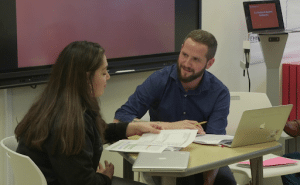 crucial role in conducting coaching conversations, assisting students in setting and achieving mastery-related goals and supporting their social-emotional well-being.
crucial role in conducting coaching conversations, assisting students in setting and achieving mastery-related goals and supporting their social-emotional well-being.
Although advisors undergo training before and during the school year to effectively coach students on their learning outcomes, the handbook offers teachers practical suggestions and strategies for conducting coaching conversations and building trusting relationships with their advisees. These coaching conversations should also happen regularly across learning spaces and not only in advisory. They serve to enhance students’ ability to apply the language of shared outcomes and rubrics, empowering them to speak confidently and make informed decisions about their learning.
Student-Led Conferences
There is no greater place to witness learner agency in action than during student-led conferences. These formal meetings, held twice a year, replace traditional parent/teacher conferences at TYWLS of Astoria. We aim to elevate these conferences beyond mere reporting or progress reviews. Instead, we intend them to be profound conversations guided by the student. Students not only describe their performance in various classes but also reflect on their learning process, establish goals, and articulate their strengths and areas for growth. This process empowers students to take charge of their learning and nurtures communication and collaboration among students, parents/caretakers, and teachers.
The Teacher Mastery Handbook is a vital resource for teachers preparing for student-led conferences (SLCs). It offers comprehensive guidance on the purpose of SLCs and emphasizes the crucial role of advisors. Advisors help coordinate SLC logistics and support students in preparing for their conferences. Additionally, teachers are guided on how to keep students informed about their progress, provide opportunities for goal-setting, and assist students in justifying their grades with evidence.
Mastery Mindset and Messaging
The Mastery Mindset and Messaging section of the handbook underscores the importance of adopting a “mastery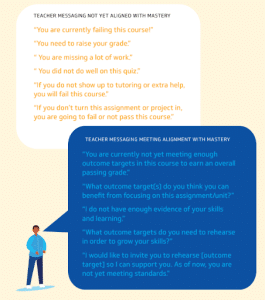 mindset” to create conditions for learner agency. This mindset involves believing that student performance should inform what students learn, viewing intelligence and skill level as malleable, and seeing reassessment as a normal part of learning. By promoting this mindset, teachers can empower students to take ownership of their learning and create an environment where assessment is used as a tool for understanding progress and providing meaningful feedback.
mindset” to create conditions for learner agency. This mindset involves believing that student performance should inform what students learn, viewing intelligence and skill level as malleable, and seeing reassessment as a normal part of learning. By promoting this mindset, teachers can empower students to take ownership of their learning and create an environment where assessment is used as a tool for understanding progress and providing meaningful feedback.
Establishing a shared or common language around learning and assessment demands an agreed-upon vocabulary and a steadfast commitment to its consistent use across all materials, from student handouts to staff professional development resources. The choice of words is crucial; it goes beyond mere semantics. For instance, my colleagues know that I’m a stickler for using the phrase “outcome opportunity” instead of “outcome recovery,” as this can significantly impact perception. If we truly value and believe in mastery as the ability to transfer skills and content knowledge across various contexts, providing students with an additional opportunity to demonstrate mastery of an outcome should be seen as just that — an opportunity. “Recovery” carries a negative undertone, suggesting that something undesirable has occurred or that a student is behind. This section of the handbook emphasizes the importance of language in messaging mastery and includes a glossary of key terms to ensure clarity and alignment in our mastery-based approach.
My Current “Final” Thoughts
On JumpRope, our school’s digital grading platform, students receive a “final rating” for each outcome target or skill taught and assessed in a course. Following the motto “don’t wait, rate,” teachers manually set or determine final ratings each time a piece of evidence is entered into the platform. However, as we emphasize to students and their parents/caretakers, the term “final rating” can be misleading. Ratings are not truly final until the end of a course, and even then, because our outcomes are shared across grade levels, students continue to grow and build mastery of these skills throughout their entire educational journey at TYWLS.
This line of thinking or philosophy is also true of our Teacher Mastery Handbook, which, despite being printed and bound, is an ongoing project. In fact, one of the final edits made to the handbook was to add the phrase “First Edition” to the back cover, signifying the potential for future editions and inviting continuous improvement and development. 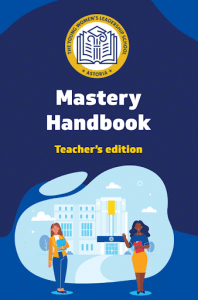
Looking ahead, we are excited to further integrate the handbook into our teacher residency program, a three-year program for new teachers at TYWLS of Astoria, as well as using it with other professional development initiatives. We are also in the final stages of publishing student and parent/caregiver editions, and eventually, a digital handbook filled with interactive videos and student anecdotes.
Thank you for following the story of the Teacher Mastery Handbook’s evolution from scattered Google Docs to a comprehensive, living guide that embodies our school’s mastery-based learning approach. I hope you found this journey through key sections of the handbook valuable and inspiring. Input from our students, parents/caretakers, and community members, along with insights from school visits and conversations with educators, has shaped much of the handbook and our work in implementing CBE. We are optimistic that, together, we can use this handbook to create a school that students feel was made for them.
Learn More
- There’s A Google Doc For That! One School’s Journey Creating a Comprehensive “Mastery Handbook”
- Beyond Packaging: Manifesting Mastery-Based Learning in the Classroom at TYWLS of Astoria
- CBE Starter Pack 1: Students are Empowered Daily
- Mindsets and Resources for Unleashing Learner Agency
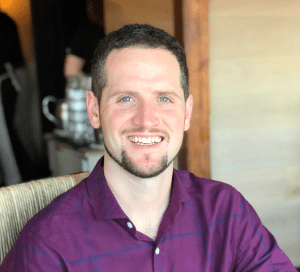
Greg Zimdahl is a middle school humanities teacher at TYWLS in Astoria, Queens, where he began teaching 16 years ago after graduating from NYU’s Steinhardt School of Education with a Bachelor of Science in Social Studies Education. In 2011, Greg earned his Master of Arts in African American Studies from the acclaimed Institute for Research in African American Studies at Columbia University. In addition to teaching, Greg currently serves as an Instructional Coach and oversees the school’s Mastery Team, including a Youth Ambassador Program. He collaborated with the founding teacher team to design and implement the school’s nationally acclaimed full school competency-based system. Greg has spearheaded several essential structures and systems at TYWLS of Astoria, such as the new Teacher Residency Program, Intensives (a ten-day, school-wide event engaging students in project-based learning with a culminating public expo), and ACT Advisory Camp TYWLS (a two-day immersive project at the start of the academic year aimed at fostering community and setting norms).